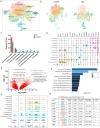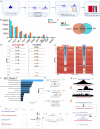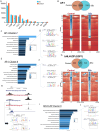This is a preprint.
Altered AP-1, RUNX and EGR chromatin dynamics drive fibrotic lung disease
- PMID: 39554071
- PMCID: PMC11565795
- DOI: 10.1101/2024.10.23.619858
Altered AP-1, RUNX and EGR chromatin dynamics drive fibrotic lung disease
Abstract
Pulmonary fibrosis, including systemic sclerosis-associated interstitial lung disease (SSc-ILD), involves myofibroblasts and SPP1hi macrophages as drivers of fibrosis. Single-cell RNA sequencing has delineated fibroblast and macrophages transcriptomes, but limited insight into transcriptional control of profibrotic gene programs. To address this challenge, we analyzed multiomic snATAC/snRNA-seq on explanted SSc-ILD and donor control lungs. The neural network tool ChromBPNet inferred increased TF binding at single base pair resolution to profibrotic genes, including CTHRC1 and ADAM12, in fibroblasts and SPP1 and CCL18 in macrophages. The novel algorithm HALO confirmed AP-1, RUNX, and EGR TF activity controlling profibrotic gene programs and established TF-regulatory element-gene networks. This TF action atlas provides comprehensive insights into the transcriptional regulation of fibroblasts and macrophages in healthy and fibrotic human lungs.
Conflict of interest statement
Conflict of Interest RL reports grants from Bristol Meyers Squibb, Formation, Moderna, Regeneron and Pfizer, EV reports grans from Boehringer Ingelheim. RL served or serves as a consultant with Abbvie, Mediar, Bristol Meyers Squibb, Formation, Thirona Bio, Sanofi, Boehringer Ingelheim, Merck, Genentech/Roche, EMD Serono, Morphic, Third Rock Ventures, Bain Capital and Zag Bio. RL sits on independent data safety monitoring committees for Advarra/GSK and Genentech. RL holds stock in Thirona Bio Inc and is president and holds stock in Modumac Therapeutics Inc.
Figures






Similar articles
-
Epigenetic Regulation of Profibrotic Macrophages in Systemic Sclerosis-Associated Interstitial Lung Disease.Arthritis Rheumatol. 2022 Dec;74(12):2003-2014. doi: 10.1002/art.42286. Epub 2022 Oct 31. Arthritis Rheumatol. 2022. PMID: 35849803 Free PMC article.
-
Matrix stiffness regulates profibrotic fibroblast differentiation and fibrotic niche activation in systemic sclerosis.Ann Rheum Dis. 2025 Jun 26:S0003-4967(25)01025-8. doi: 10.1016/j.ard.2025.05.016. Online ahead of print. Ann Rheum Dis. 2025. PMID: 40579317
-
Cyclophosphamide for connective tissue disease-associated interstitial lung disease.Cochrane Database Syst Rev. 2018 Jan 3;1(1):CD010908. doi: 10.1002/14651858.CD010908.pub2. Cochrane Database Syst Rev. 2018. PMID: 29297205 Free PMC article.
-
Spatial multiomics decipher fibroblast-macrophage dynamics in systemic sclerosis.Ann Rheum Dis. 2025 Jul;84(7):1231-1245. doi: 10.1016/j.ard.2025.04.025. Epub 2025 May 22. Ann Rheum Dis. 2025. PMID: 40410053
-
Cellular crosstalk in fibrosis: Insights into macrophage and fibroblast dynamics.J Biol Chem. 2025 Jun;301(6):110203. doi: 10.1016/j.jbc.2025.110203. Epub 2025 May 5. J Biol Chem. 2025. PMID: 40334985 Free PMC article. Review.
Cited by
-
Genomic resources, opportunities, and prospects for accelerated improvement of millets.Theor Appl Genet. 2024 Nov 20;137(12):273. doi: 10.1007/s00122-024-04777-9. Theor Appl Genet. 2024. PMID: 39565376 Free PMC article. Review.
References
Publication types
Grants and funding
LinkOut - more resources
Full Text Sources
Research Materials
Miscellaneous
